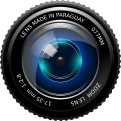Understanding Exposure
Understanding exposure is important for taking beautiful pictures of the sun rising & setting. The amount of light that reaches the camera sensor is referred to as exposure. The image will be overexposed and lose details in the bright parts if the exposure is set too high. The image will be underexposed and the details in the dark areas will be lost if the exposure is set too low.
Aperture
The aperture is the hole in the lens of the camera through which light enters the device. To regulate the quantity of light that reaches the camera sensor the aperture size can be changed. In low-light situations, such as around sunset and dawn a bigger aperture (lower f-number) allows more light to enter. To let more light into the camera it is advised to use a larger aperture such as f/2.8 or f/4.
Shutter Speed
The length of time the camera's shutter is left open so that light may reach the camera sensor is referred to as the shutter speed. Slower shutter rates will let in more light, but they can also cause camera shake, which will cause a picture to be fuzzy. It is advised to use a slower shutter speed of 1/30th of a second or slower for dawn and sunset photography.
ISO
ISO refers to the sensitivity of the camera sensor to light. A higher ISO value will make the camera sensor more sensitive to light allowing it to capture images in low-light conditions. However using a high ISO can also result in image noise, which can be seen as graininess in the image. For sunrise and sunset photography it is recommended to use a low ISO value of 100 or 200 to keep the image as noise-free as possible.
White Balance
The colour temperature of the light in a scene is referred to as white balance. Setting the white balance correctly can assist guarantee that the colours in your image are true and realistic since different light sources have varied colour temperatures. It is advised to choose a warm white balance option for dawn and sunset photography, such as "daylight" or "cloudy," to bring out the warm hues in the sky.
Using a Tripod
When photographing a sunset or dawn, a tripod may be quite useful, especially when utilising slower shutter speeds. Your pictures will be sharp and clear because a tripod will assist the camera stay stable and prevent camera wobble.
Experimenting with Composition
Experimenting with different compositions can help you create unique and stunning sunset and sunrise photos. Try including foreground elements, such as trees or rocks, to add depth and interest to your images. You can also try using leading lines, such as roads or rivers, to guide the viewer's eye through the image.
Conclusion
Sunset and sunrise photography can be a challenging & rewarding experience for photographers. By understanding the importance of exposure, aperture, shutter speed ISO & white balance as well as using a tripod and experimenting with composition you can capture stunning and unique images that truly capture the beauty of a sunrise or sunset.

